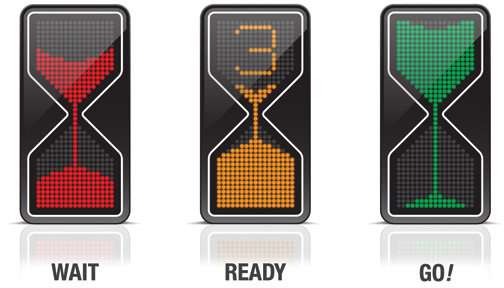Neither flashing traffics lights nor the colour yellow deter pedestrians from crossing

A study by scientists at the University of Granada (UGR) has shown that neither flashing traffic lights and nor the colour yellow have any effect on pedestrians. Only the two mandatory phases–steady green and steady red–are deterrents for pedestrians, communicating a clear, safe message.
The research–published in the the Spanish Journal of Psychology–was conducted by scientists at the UGR's "Brain Mind and Behavior" Research Center. The aim was to contribute to the design of more effective traffic signals to prevent people taking risks at traffic light controlled crosswalks.
The authors worked with a sample of 247 participants, most of whom (74.89%) had a valid driving license. All were presented with a series of photographs of various pedestrian crosswalks controlled by traffic lights in the centre of Granada.
Participants were shown different crosswalks with both real and modified traffic light regulation. They were asked to rate each situation from 1 to 10 as to whether or not they would cross (1 being "Never cross in that situation" and 10 "Always cross in that situation").
The types of traffic light that the researchers suggested to participants were: a steady green light, flashing green, steady yellow, flashing yellow, steady red, flashing red and lights off.
Steady red and green, the most effective
The results revealed some curious facts. Many pedestrians do not know the meaning of the non-mandatory phases of traffic lights, that is, those other than green (go) or red (don't-go). In addition, the options involving a flashing light and the colour yellow are not effective at communicating a clear, safemessage.
The researchers found that the mandatory solutions (steady green/steady red) are the best options to avoid unsafe pedestrian behaviour when crossing at controlled crosswalks.
University of Granada researchers Leandro L. Di Stasi and Alberto Megías–principal authors of the study–say that "in the European Union there are no specific, common regulations for traffic signals. For example, in Italy, as well as steady green/steady red, there is a yellow phase for pedestrians. In France, there is a flashing red phase, and in Spanish cities like Granada, a flashing green light indicates an imminent change to red".
Sand glass
Di Stasi and Megías suggest that introducing an easy, effective solution to create safer, pedestrian-friendly environments "would be to use a traffic light that only has the two mandatory phases–green and red–with an indication of the time remaining before the switch to the next phase: for example, an image of a sand glass with a countdown".
Another type of light that they consider would be effective is called a Marshalite, which was first used in Australia in 1936 and takes its name from Charles Marshall who designed it. Marshalites were used there for thirty years. They had two motorized rotors that moved hands like on a clock face to point to the relevant section: red, yellow or green.
The researchers suggest that the lack of common standards and the ambiguous messages about intermediate stages (steady or flashing lights) "could diminish road safety levels, contributing to the high number of accidents that occur annually in Europe at signalised junctions–equally common in Spain, according to the Spanish Interior Ministry's Directorate-General for Traffic (DGT)"
More information: "The Influence of Traffic Signal Solutions on Self-Reported Road-Crossing Behavior." The Spanish Journal of Psychology (2014), 17, e103, 1–7. DOI: 10.1017/sjp.2014.105





















